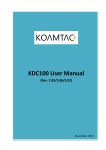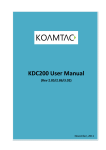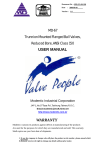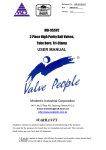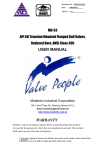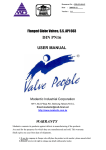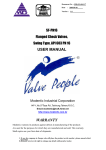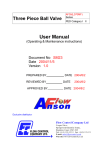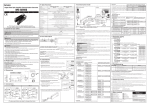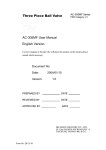Download Spilt body Flange ball valve TC-205MFF
Transcript
Spilt body Flange ball valve TC-205MFF-PN1640 Series PED Category I,II TC-205MFF-PN1640 User Manual English Version Use for company in Europe who will place the product on the market, please amend which necessary. Document No: TC-205MFF-PN1640.Ur-manual Date: 2007/04/2617 Version: 1.0 Form No. QF-21-01 1 a. Material Selection: The possibility of material deterioration in service and the need for periodic inspections is depended on the contained fluid. Carbide phase conversion to graphite, oxidation of ferrite materials, decrease in ductility of carbon steels at low temperature (even in applications above -29℃) are among those items. Even information about corrosion data is provided in this user manual, the user is requested to take attention or consideration to determine the suitability of material in their application. b. Pressure-Temperature rating: The Pressure-Temperature rating is considered for static pressure. Please refer to P & T rating section on page 9 for working precaution. The allowable temperature is between R.T. and 160℃ do not exceed the temperature range to avoid danger accident happen. c. Fluid thermal expansion: It is possible, when the ball valve is in closed condition, the sealed cavity within the valve body to be filled with liquid. If this liquid is not released, by partially opening the valve or some other means, and it is subject to a temperature increase, excessive pressure sufficient to cause pressure boundary failure can be generated. However our products have pressure self-relief seat to prevent pressure built up, user is recommended to prevent that the pressure in the valve will not exceed that allowed pressure, by means of piping design, installation, or operation procedure. d. Static electric effect: The ball valves are provided with anti-static devices for ball-stem-body. When service conditions require electrical continuity to prevent static discharge, the user is responsible for specifying static grounding. e. Fire safe condition: Generally, the application of the valve shall comply with the Pressure-Temperature rating range. If the risk of fire is major effect, user is recommended to select our fire-safe products, which with API-607 approval. Contact to the valve distributor or manufacturer for details. f. Liquids with high fluid velocity: When ball valves must be operated frequently on liquids with very high velocity, a check shall be made with the valve distributor or manufacturer for appropriate advice to minimize the possibility of seat deformation, especially when they are highly pressurized on high-temperature line. g. Throttling service: Ball valves are generally not recommended for throttling service, where both the fluid flow and the leading edge of the ball can damage or deform the resilient ball seats causing leakage. High fluid velocity or the presence of solid particles in suspension will further reduce seat life in throttling applications. Form No. QF-21-01 2 h. Do not open the bonnet or cap when bearing pressure. Valve is not equipped with pressure access device. User should check it by other method through its piping system. i. No touch the surface of valve on high temperature. j. Not allowed for unstable fluid, otherwise specified with catogory III in Declaration of conformity or/and in this user manual. k. Lock design on the handle to avoid the valve operated by non-related people is optional requested by the user. 2. Product Description 2.1 Feature a. FULL BORE ball valve. b. Direct-mounting of actuator to valves, low cost and easy automation c. Bottom Entry Blow-Out Proof Stem design Provides Maximum Safety. d. Anti-static devices for ball-stem-body. e. Integral Twin pattern ISO 5211 mounting pad for double active & spring return actuator. f. Heavy-duty body & end cap construction with traceable heat number. g. Self-adjusting stem packing assembly with Belleville spring for temperature fluctuations, vibration, and is secured. h. Pressure self-relief seat to prevent pressure built up. i. Lock design on the handle is optional requirement. 2.2 Product specification The scope of product specifications are as following. The category levels we wsed , and in according to group 1 , gas fluid , because we are hard to know the application of end user sizes under and including DN 25 or 1” valves will not be bean a CE mark in according to the PED directive. Form No. QF-21-01 3 4. Pressure Temperature Ratings The pressure-temperature rating of ball valves are determined, not only by valve shell materials, but also by sealing materials used for ball seats, stem packings, and body seal. Sealing materials may be high molecule, elasticity and hardness, however, the choice is limited by the characteristics of the service fluid, temperature, pressure, velocity of fluid, frequency of valves operation and sizes of ball valves etc, Followings are the general rating charts for non-shock fluid service for floating ball valves distinguished by sizes and seating materials, please refer to section 1, General precaution. Form No. QF-21-01 5 5. Delivery Condition and Storage Valves stay in the open condition during the transportation. For incoming QC, it must check: a. Packing condition: Is there any damaged during the transportation. b. The bolts of cap and yoke: to make sure the bolt does not loose tightness when it arrived. Valves must store in an indoor warehouse to avoid dusts and other foreign object, do not exposed in an open space without to put a cover over or take off the packing under an unnecessary situation. 6. Installation and Operation 6.1 Handling During the ball valve installation, it must follow the procedure to hand at the both side of the bodies, the cable must be strong enough to ensure the safety during the installation. 6.2 Cleaning Even the valves was transported under a clean environment, operator must check is there any foreign body or dusts inside the bore. If yes, clean it before installation. Operator clean the valves by water, compression air, or steam (automation valve shall be cleaned only with water or steam, the compression air is not allowed.) For cleaning operation, first step is put the valve bore perpendicular to the ground and clean, ensure all the dusts can be removed from the bore. The second step is checking and clean all the connecting pipe bore and connection area. No flush, rust and foreign bodies allow to avoid the blocking and leakage. 6.3 Valve Installation (Install to the pipeline system) a. Direction Most of the valves do not restrict the flow direction. b. Position The body, cap and gasket are in the connection area of ball valve and pipeline. The bear weight ability and gradient are very important to the pipe installation. Do not make the pressure from the pipeline and stress to concentrate on the connecting area of body and cap. It will cause the deformed and leakage, and the ball, seat, and stem will stick, leaking, and damaged. c. Fittings Select the correct specification of bolts to fasten the flange with pipeline. Following table show fitting information, which is according to DIN 2545 & DIN 2543. Form No. QF-21-01 6 To tight the bolts of the flange end caps, the force must distribute on the every single bolt evenly. The order to tight the bolts need to install symmetrically. See the drawings below. Please see the drawings below for the order of bolts installation. d. Systems hydrostatic test Before delivery, valves are tested 1.5 times the allowable pressure at ambient temperature in open position. After installation, the piping system may subject to system tests, as condition not to exceed the above mentioned pressure. 6.4 Actuator installation The ball valves are provided with ISO 5211 actuator attachment. Following is the flange type against sizes of the ball valves. Form No. QF-21-01 7 The sizes of actuator and setting of the input power or pressure of actuator are depended on the operation torque. The following table lists the maximum torque values of each flange type. User is recommended to refer to the instruction of actuator supplier. Overload torque applied by the actuator may transfer the un-intended load to ball valve itself or to the piping joints. Setting of the input power or pressure of the actuator is better not to exceed 1.5 times of the operation torque data. 6.5 Operation a. For manual operation, shift the handle in counter clockwise direction for close and clockwise for opening. b. If the handle is in parallel position with the flow direction, the valve is open. If the handle is in right angle position with the flow direction, the valve is close. c. When installing actuator or the valve is operated with removable handle, the user should ensure the position of the valve whether open or close. There is sign at the top of stem for square type stem. Following with the fig-4. Showing how to access the position of ball valve. Form No. QF-21-01 8 7. Put into service 7.1After install to the pipe line, it is necessary to check the function of the product. Thus, operate the valve about 3 times to ensure the function. 7.2The whole pipe line system may be tested with a proper pressure. User shall take care that the testing pressure shall not be exceeded 1.5 times the allowed working pressure. 7.3After pressure testing, user shall operate the valve again about 3 times to ensure the function. 8. Dangers of inappropriate use 8.1 Never use the product exceed its allowed condition, such as pressure, temperature and fluid. 8.2 If the product have any inappropriate use, the product was damage however there are no signal occur immediately. User shall change the product to avoid danger in the future. 9. Maintenance 9.1 Maintenance frequency The maintenance frequency is determined upon the application of ball valve. User shall consider the time interval depend on the kinds of fluid, flow velocity, operation frequency, high-pressure effect and high-temperature effect etc. minimum wall thickness acc to tab 3.2 etc. 9.2 Disassembly a. The user should check the kit of TC-205MFF-PN16 if available in the local market, if not, please do not disassembly the valve, otherwise, please make a order from the original manufactory for the kit of TC-205MFF-PN16. b. To dismantle the valve must follow the procedure and drawings below. c. It doesn’t matter where is the position of valve located, usually it contained the seal up fluid, so operator must be very carefully when move the valve on the pipe. It must open the ball a little and let the fluid come out slowly, it also need to watch out the poisonous and inflammability objects if there is any. d. It must turn the ball in the close position before dismantle the valve. The ball cannot be taken out from valve body if the ball is in the open or semi-open position. The right position for store the valve is put the flange end on the ground. If it is a valve with the hand wheel, than it must dismantle the hand wheel from the valve first than put the valve flange end on the ground. This procedure is protecting the surface of the ball. e. To dismantle the valve body and end cap, release the bolts symmetrically. It must be careful to dismantle the ball to avoid the seat retainer fall down from end cap. Form No. QF-21-01 9 f. To lift the ball by hoist, it must make the protection on corner to avoid the ball damaged by metal contacted. 9.3 Parts inspection, maintenance and replacement: a. Check the surface of ball is it scraped? It may use the PT for inspection if necessary. If there is any damaged on the surface, than found out the root cause such as the dirt fluid…etc. It must avoid the damage factors as far as possible. b. The damaged of the ball surface, to gauge is it located on the contacting area of ball and ball seat? If it is the case, than the ball must take a fine milling. If it cause a heavy damaged, than it must welded and re-machined again. If it cannot be repaired than change a new ball. c. If the scraped area is not at the location described in the item b above, than it must re-fine milling the damage area again. Otherwise, the ball will damage the soft seat during the open and close operation or it will dig out the ball seat and cause a heavy damage to ball and seat. d. To inspect the surface of soft seat, has it any scrape mark, concave, dusts (including weld dregs, iron bit, sands…etc.), abrasion, abnormal press scrape, and a tiny scrape. Usually, the scrape mark and damage by dusts will occur the same time as ball damaged. It is the root cause for leakage. If leakage occur before repairing, than suggest to change a new soft seat. The mark from press or fine scrape is happen in an abnormal operation pressure. It must reconsider to choice a right valve. Form No. QF-21-01 10 e. The stem packing may be replaced by the new parts after dismantle the valve. User shall make sure that the your distributor able to serve the same packing of your valve if you do not have a service pack. To tight the bolt and nut, please see Section 8 for torque data. f. To do the final inspection for a valve, it must operate 10 times of open and close to ensure all the parts are assemble correctly. To ensure the torque in a same value during the open/close operation. If the torque is not the same in operation, than it may has some parts in a not corrected position or interference. It must dismantle and re-assembly. Otherwise, it is easy to damage if let this valve works on a pipeline under higher pressure. 9.4 Assembly For assembly process, it takes the opposite way of dismantle process. The must in the close position during assembling the body and end cap, the stopper must be located at the right place, otherwise, the open and close operation will be opposite. 10. Torque Data Form No. QF-21-01 11


































